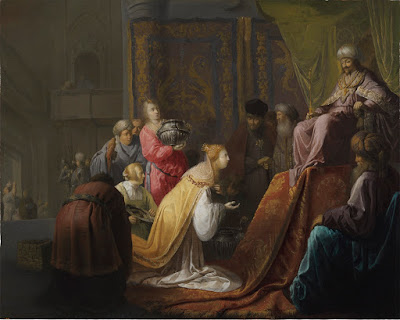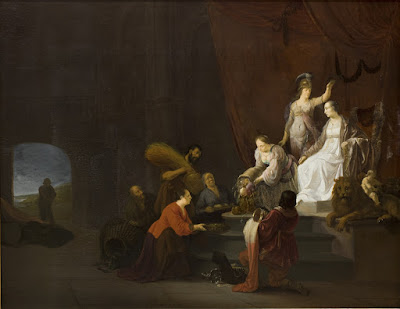 |
| Willem de Poorter Solomon and the Queen of Sheba ca. 1630 oil on panel Leiden Collection, New York |
 |
| Willem de Poorter Solomon and the Queen of Sheba before 1668 oil on panel Mount Edgecumbe House, Cornwall |
 |
| Willem de Poorter Idolatry of King Solomon ca. 1630-48 oil on panel Rijksmuseum, Amsterdam |
 |
| Willem de Poorter Mercury and Proserpina ca. 1633-48 oil on panel Statens Museum for Kunst, Copenhagen |
 |
| Willem de Poorter Artemisia receives the Ashes of Mausolus before 1668 oil on panel Rhode Island School of Design Museum, Providence |
 |
| Willem de Poorter Lucretia among her Maids, with Tarquin approaching 1633 oil on panel Musée des Augustins de Toulouse |
 |
| Willem de Poorter The Gold-Weigher ca. 1637 oil on panel North Carolina Museum of Art, Raleigh |
 |
| Willem de Poorter St Paul and St Barnabas at Lystra 1636 oil on panel Minneapolis Institute of Art |
 |
| Willem de Poorter Allegory of Peace (Peace crowned by Minerva) 1643 oil on panel Statens Museum for Kunst, Copenhagen |
 |
| Willem de Poorter Vanitas Allegory before 1668 oil on panel Nationalmuseum, Stockholm |
 |
| Willem de Poorter Vanitas Still Life 1636 oil on panel Museum Boijmans Van Beuningen, Rotterdam |
 |
| Willem de Poorter Josiah burning the Bones at Bethel ca. 1635-45 drawing British Museum |
 |
| Willem de Poorter Stoning of St Stephen before 1668 drawing Harvard Art Museums |
 |
| Willem de Poorter Study of Draped Figure before 1668 drawing Kupferstich-Kabinett, Dresden |
"Willem de Poorter (1608-1668), the son of a Flemish émigré, was likely born in Haarlem. The circumstances of his training are not clear. It is often proposed that he studied with Rembrandt van Rijn in Leiden, about 1629-30. That training, however, may have occurred in Amsterdam as late as the mid-1630s, thereby constituting not a student-pupil relationship so much as a mid-career supervision. By 1633 De Poorter's name appears in the Haarlem city archives, where he is listed as a member of the Guild of Saint Luke by 1635. . . . According to Arnold Houbraken, De Poorter was a specialist of history and still-life painting, though only a few of the latter survive. Today he is best known for his religious and mythological works, some of which bear stylistic affinities to the early work of Rembrandt as well as to that of Rembrandt's teacher, Pieter Lastman. Like Rembrandt and Lastman, De Poorter set his scenes in large, dark interiors with a central grouping of figures differentiated through animated expression and pose. . . . His smooth manner of execution, figure types, and use of bright localized colors against a monochrome background are [also] closely reminiscent of the works of Hendrik Gerritsz Pot and Pieter de Grebber."
– from a biographical sketch at the Leiden Collection, New York
 |
| Willem de Poorter Portrait of a Young Man 1634 oil on panel St John's College, University of Oxford |